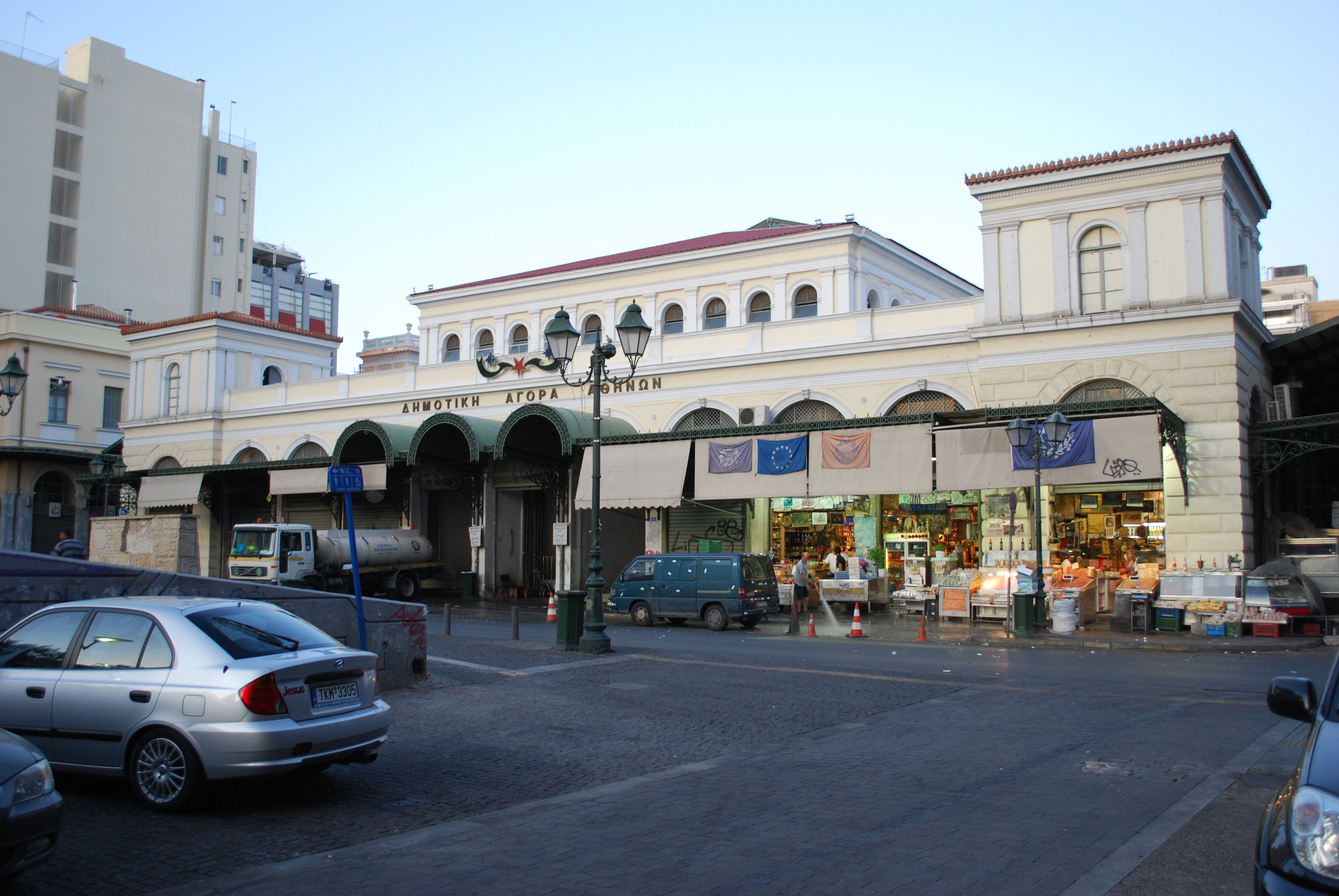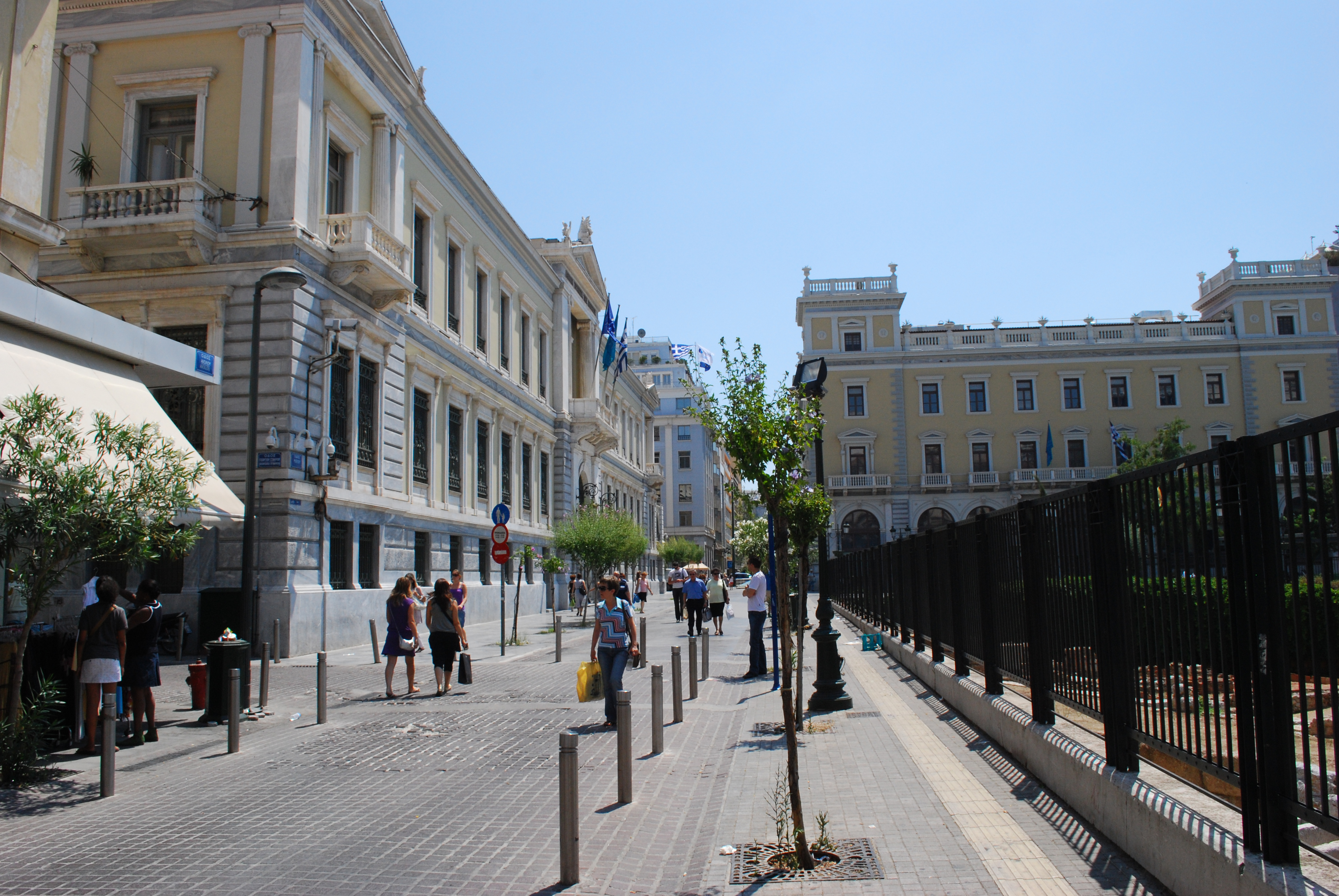|
Athinas Street
Athinas Street ( el, Οδός Αθηνάς) is a street in downtown Athens in Greece. It is named after Athena, the goddess of wisdom. The street runs from Ermou Street north to Omonoia Square through the Psiri neighborhood. Its total length is nearly 1 km of which 80 m is a walkway since 1999. Until 1999, it used to access with Omonoia Square, now motorists can now access it via Lykourgos Street east to Aiolou and 28 Oktovriou (Patissi) Street and other streets. North of Lykourgos is a pedestrian walkway. It has two lanes of traffic and room for curb parking. Famous buildings includes the Athens City Hall on the west side and office towers northward. The Modern Agora is east of Athinas Street. Kotzia Square lies to the east with Karamanou Square also on the east. Shops and residential buildings lies to the south with neo-classical buildings. In the middle of Athinas street is the Varvakeios municipal market. The oldest market in Athens The rest of the arch ... [...More Info...] [...Related Items...] OR: [Wikipedia] [Google] [Baidu] |
Athens - Kotzia Square And City Hall - 20060508
Athens ( ; el, Αθήνα, Athína ; grc, Ἀθῆναι, Athênai (pl.) ) is both the capital and largest city of Greece. With a population close to four million, it is also the seventh largest city in the European Union. Athens dominates and is the capital of the Attica region and is one of the world's oldest cities, with its recorded history spanning over 3,400 years and its earliest human presence beginning somewhere between the 11th and 7th millennia BC. Classical Athens was a powerful city-state. It was a centre for the arts, learning and philosophy, and the home of Plato's Academy and Aristotle's Lyceum. It is widely referred to as the cradle of Western civilization and the birthplace of democracy, largely because of its cultural and political influence on the European continent—particularly Ancient Rome. In modern times, Athens is a large cosmopolitan metropolis and central to economic, financial, industrial, maritime, political and cultural life in Greece. In 202 ... [...More Info...] [...Related Items...] OR: [Wikipedia] [Google] [Baidu] |
Aiolou Street
Aiolou Street (also Eolou Street; el, Οδός Αιóλου) is a street in downtown Athens, the Greek capital. It is named after Aeolus, the god of winds in Greek mythology. The street is one-way and originally ran entirely southbound but since the closure of Athinas Street in the late-1990s as part of the renovation plan, the part north of Lykourgou Street is one-way northbound. The street begins in Pelopidas Street further south of Ermou Street and ends in Panepistimiou Street (Eleftheriou Venizelou Avenue) and north of this street is 28 Oktovriou or Patission Street. History The street was first laid in the 19th century and was the first street in Athens to be paved. Neoclassical buildings were built then as well and are still present today in the southern and the central part of the street. After World War II and the Greek Civil War, modern eight to ten storey buildings were built in the northern part and traffic lights were installed on Adrianou, Ermou, Evrypidou, Sof ... [...More Info...] [...Related Items...] OR: [Wikipedia] [Google] [Baidu] |
Omonia Metro Station
Omonia ( el, Ομόνοια, ) is an underground station under the Omonoia square of Athens, used by Athens Metro The Athens Metro ( el, Μετρό Αθήνας, Metro Athinas, translit-std=iso) is a rapid-transit system in Greece which serves the Athens urban area and parts of East Attica. Line 1 opened as a conventional steam railway in 1869 and electrif ... lines 1 and 2. The first station opened 1895 but had been completely redesigned until 1930 as an underground Metro station. In January 2000 the additional platforms for Line 2 were opened. Interchanges Station layout References External links Athens Metro stations located underground Railway stations located underground Railway stations opened in 1895 Railway stations opened in 2000 1895 establishments in Greece {{Athens-struct-stub ... [...More Info...] [...Related Items...] OR: [Wikipedia] [Google] [Baidu] |
20090801 Athina38
9 (nine) is the natural number following and preceding . Evolution of the Arabic digit In the beginning, various Indians wrote a digit 9 similar in shape to the modern closing question mark without the bottom dot. The Kshatrapa, Andhra and Gupta started curving the bottom vertical line coming up with a -look-alike. The Nagari continued the bottom stroke to make a circle and enclose the 3-look-alike, in much the same way that the sign @ encircles a lowercase ''a''. As time went on, the enclosing circle became bigger and its line continued beyond the circle downwards, as the 3-look-alike became smaller. Soon, all that was left of the 3-look-alike was a squiggle. The Arabs simply connected that squiggle to the downward stroke at the middle and subsequent European change was purely cosmetic. While the shape of the glyph for the digit 9 has an ascender in most modern typefaces, in typefaces with text figures the character usually has a descender, as, for example, in . The mod ... [...More Info...] [...Related Items...] OR: [Wikipedia] [Google] [Baidu] |
Line 1 (Athens Metro)
Line 1 is the oldest of the three lines of the Athens Metro, running from to . The Athens-Piraeus Railway Company (SAP S.A.) first opened the line, between and , on 27 February 1869. On 4 February 1885 Lavrion Square-Strofyli railway line opened between Attiki Square and . These railway lines gradually merged and converted to a rapid-transit system. It was merged into the Athens Metro network upon the opening of Lines 2 and 3 on 28 January 2000. Network Line 1 connects the port of Piraeus with the northern suburb of Kifissia. It is built to and is electrified using the 750 V DC, third rail, top contact system, also used by Lines 2 and 3. From Piraeus the line runs eastwards to Faliro and then north to Moschato, Kallithea, Tavros, Petralona, Thissio, Monastiraki, Omonia, Victoria and Attiki. Between Monastiraki and Attiki the line runs underground. At Monastiraki passengers can change to Line 3 and at Omonia and Attiki to Line 2. From Attiki the line continues north, ... [...More Info...] [...Related Items...] OR: [Wikipedia] [Google] [Baidu] |
Kotzia Square
Kotzia Square ( el, Πλατεία Κοτζιά) is a square in central Athens, Greece. The square retains several characteristics of 19th-century local neoclassical architecture, such as the City Hall of the Municipality of Athens and the National Bank of Greece Cultural Center. It is named after Konstantinos Kotzias, former Mayor of Athens. Location The square is surrounded by the following streets: Efpolidos Street to the north, Athinas Street to the west, Kratinou to the south, and Aiolou Street from the east. The square itself is south of Omonia Square and north of Monastiraki square. Kotzia square lies in front of the City Hall of the Municipality of Athens,Kotzia Square/City Hall Plaza/National Resistance Square Page. Greeceathensageaninfo.co ... [...More Info...] [...Related Items...] OR: [Wikipedia] [Google] [Baidu] |
Athens City Hall
Athens ( ; el, Αθήνα, Athína ; grc, Ἀθῆναι, Athênai (pl.) ) is both the capital city, capital and List of cities and towns in Greece, largest city of Greece. With a population close to four million, it is also the seventh List of urban areas in the European Union, largest city in the European Union. Athens dominates and is the capital of the Attica (region), Attica region and is one of the List of oldest continuously inhabited cities, world's oldest cities, with its recorded history spanning over 3,400 years and its earliest human presence beginning somewhere between the 11th and 7th millennia BC. Classical Athens was a powerful Greek city-state, city-state. It was a centre for the arts, learning and philosophy, and the home of Plato's Platonic Academy, Academy and Aristotle's Lyceum (classical), Lyceum. It is widely referred to as the cradle of civilization, cradle of Western culture, Western civilization and the democracy#History, birthplace of democracy, larg ... [...More Info...] [...Related Items...] OR: [Wikipedia] [Google] [Baidu] |
28 Oktovriou (Patissi) Street
8 (eight) is the natural number following 7 and preceding 9. In mathematics 8 is: * a composite number, its proper divisors being , , and . It is twice 4 or four times 2. * a power of two, being 2 (two cubed), and is the first number of the form , being an integer greater than 1. * the first number which is neither prime nor semiprime. * the base of the octal number system, which is mostly used with computers. In octal, one digit represents three bits. In modern computers, a byte is a grouping of eight bits, also called an octet. * a Fibonacci number, being plus . The next Fibonacci number is . 8 is the only positive Fibonacci number, aside from 1, that is a perfect cube. * the only nonzero perfect power that is one less than another perfect power, by Mihăilescu's Theorem. * the order of the smallest non-abelian group all of whose subgroups are normal. * the dimension of the octonions and is the highest possible dimension of a normed division algebra. * the first number ... [...More Info...] [...Related Items...] OR: [Wikipedia] [Google] [Baidu] |
Lykourgos Street
Lycurgus or Lykourgos () may refer to: People * Lycurgus (king of Sparta) (third century BC) * Lycurgus (lawgiver) (eighth century BC), creator of constitution of Sparta * Lycurgus of Athens (fourth century BC), one of the 'ten notable orators' at Athens * Lykourgos Logothetis (1772–1850), leader of Samos in the Greek War of Independence * Lycurgus Johnson (1818–1876), American cotton planter and politician * Lycurgus J. Rusk (1851–1928), American politician * Lycurgus Conner (1909–1963), American politician * George Lycurgus (1858–1960), Greek–American businessman and Hawaiian royalist Mythology * Lycurgus (mythology), name of mythological characters named Lycurgus * Lycurgus of Arcadia, king * Lycurgus (of Nemea), son of Pheres * Lycurgus of Thrace, king, opponent of Dionysus * Lycomedes or Lycurgus, in Homer * Lycurgus, son of Pronax * Lycurgus, son of Heracles by Toxicrate, daughter of Thespius * Lycurgus, a suitor of Hippodamia of Pisa Places * Lycurgus, I ... [...More Info...] [...Related Items...] OR: [Wikipedia] [Google] [Baidu] |




.png)